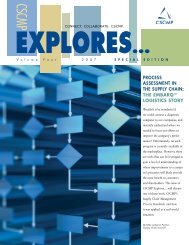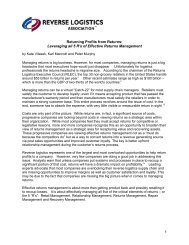is your metrics program measuring up? - Supply Chain Visions
is your metrics program measuring up? - Supply Chain Visions
is your metrics program measuring up? - Supply Chain Visions
Create successful ePaper yourself
Turn your PDF publications into a flip-book with our unique Google optimized e-Paper software.
Metrics Aligned<br />
and Driven by<br />
Corporate<br />
Goals<br />
Balanced<br />
Scorecard of<br />
Performance<br />
Measures<br />
Measurement<br />
Process and<br />
Culture<br />
Process<br />
Focused<br />
Metrics<br />
HOW DOES YOUR METRICS PROGRAM MEASURE UP?<br />
Poor Practice<br />
• Key Performance<br />
Indicators (KPIs)<br />
are poorly<br />
defined with<br />
weak links to<br />
goals.<br />
• Financial measures<br />
are the primary<br />
measures<br />
of performance.<br />
• Metrics are<br />
used sporadically—either<br />
functionally or<br />
individually.<br />
• Metrics offer<br />
little ability to<br />
capture or<br />
track data for<br />
nonfinancial<br />
measures.<br />
• Financial measures<br />
are the primary<br />
measures<br />
of performance.<br />
2805 Butterfield Road, Suite 200, Oak Brook, IL 60523-1170 USA<br />
Phone (630) 574-0985 • Fax (630) 574-0989 • www.clm1.org<br />
Inadequate Practice Common Practice Good Practice Best Practice<br />
• The KPIs required<br />
to achieve company<br />
goals are clearly<br />
defined.<br />
• Each functional department<br />
or work team<br />
measures the performance<br />
of its own process.<br />
• Manipulation or gaming<br />
of <strong>metrics</strong> occurs to<br />
achieve desired results<br />
(e.g. on-time fill rate to<br />
commit vs. request).<br />
• Metrics are reported<br />
on a regular bas<strong>is</strong>, but<br />
often used by only a<br />
few individuals.<br />
• Data integrity leads to<br />
a m<strong>is</strong>trust of measures.<br />
• Functional and financial<br />
<strong>metrics</strong> are used,<br />
but may be driving<br />
suboptimization.<br />
• There <strong>is</strong> no clear linkage<br />
between functional<br />
<strong>metrics</strong> and their<br />
financial leverage.<br />
• No measure of Perfect<br />
Order <strong>is</strong> maintained.<br />
• The KPIs required to<br />
achieve company goals<br />
are clearly defined and<br />
measured.<br />
• Each functional department<br />
or work team<br />
measures the performance<br />
of its own process.<br />
• Functional measures are<br />
aggregated to form a<br />
company-wide view.<br />
• Metrics are clearly d<strong>is</strong>played<br />
within the company, and<br />
communicated companywide<br />
(e.g. intranet, etc.).<br />
• Definitions are clear and<br />
agreed <strong>up</strong>on.<br />
• Reports are “seen” but not<br />
“used” by the majority of<br />
employees.<br />
• Most managers don’t use<br />
reports to drive the business.<br />
• Data integrity <strong>is</strong>sues may<br />
ex<strong>is</strong>t—but are actively<br />
being addressed as they’re<br />
d<strong>is</strong>covered.<br />
• Elements of process <strong>metrics</strong><br />
are collected, but not<br />
actively aligned to drive<br />
process behavior.<br />
• KPIs are defined, performance<br />
<strong>is</strong> measured,<br />
and targets are set.<br />
•A top 10 l<strong>is</strong>t (or similar)<br />
drives functional<br />
behavior and company<br />
goals.<br />
•A balanced scorecard of<br />
market, process, and<br />
financial measures <strong>is</strong><br />
used to make informed<br />
dec<strong>is</strong>ions and track performance.<br />
•Process <strong>metrics</strong> and<br />
results <strong>metrics</strong> are<br />
balanced to prevent<br />
suboptimization.<br />
• Metrics are used as a<br />
part of regular review<br />
meetings for all functions<br />
to drive business<br />
improvements.<br />
• Data <strong>is</strong> turned into<br />
information to make<br />
dec<strong>is</strong>ions.<br />
• Metrics reports are used<br />
by key employees and<br />
managers to drive the<br />
business.<br />
•A clear understanding<br />
of the financial impact<br />
of <strong>metrics</strong> ex<strong>is</strong>ts across<br />
all levels.<br />
• Elements of process<br />
<strong>metrics</strong> are in place and<br />
actively viewed from a<br />
process perspective on<br />
a regular bas<strong>is</strong>.<br />
• Indexing (such as<br />
Perfect Order Index) <strong>is</strong><br />
performed on an ad<br />
hoc bas<strong>is</strong>.<br />
• Each KPI <strong>is</strong> clearly defined with<br />
an actual-to-target gap analys<strong>is</strong><br />
and improvement plan.<br />
• An embedded <strong>metrics</strong> hierarchy<br />
ex<strong>is</strong>ts to associate functional<br />
<strong>metrics</strong> to a top 10 l<strong>is</strong>t, and to<br />
provide drill downs as needed<br />
(e.g. nested measures with red/<br />
yellow/green indicators).<br />
•A balanced scorecard of<br />
customer, operational,<br />
employee, and financial<br />
measures <strong>is</strong> used to make<br />
informed dec<strong>is</strong>ions and<br />
track performance.<br />
• Improvement targets and<br />
plans are in place to s<strong>up</strong>port<br />
each measure.<br />
•Metrics are used as a part<br />
of regular review meetings<br />
across all functions and<br />
levels (e.g. linking strategy<br />
to shop floor <strong>metrics</strong> to<br />
ensure all employees are<br />
marching to the beat of<br />
one drum).<br />
•Metrics are used to drill<br />
down and change the process<br />
to get the desired results.<br />
• Metrics are clearly d<strong>is</strong>played<br />
within the company, and<br />
have been made a part of<br />
the culture.<br />
• Active indexing (such as<br />
the Perfect Order Index) <strong>is</strong><br />
used with key <strong>metrics</strong>—<br />
root cause drill down <strong>is</strong><br />
readily available through<br />
linkage.<br />
• Measures are used with<br />
customers to agree <strong>up</strong>on<br />
process improvements.<br />
PRSRT STD<br />
US POSTAGE<br />
PAID<br />
CHICAGO, IL<br />
PERMIT #9711<br />
© 2004 S<strong>up</strong>ply <strong>Chain</strong> V<strong>is</strong>ions – all rights reserved




